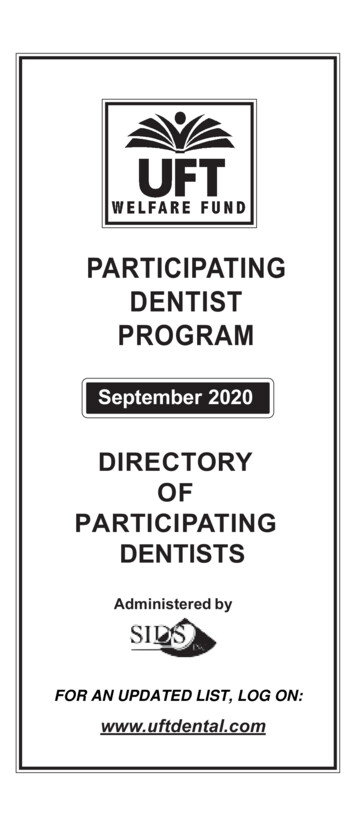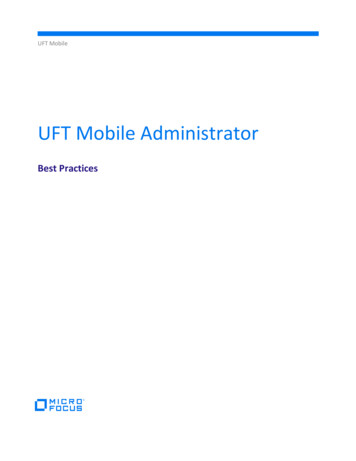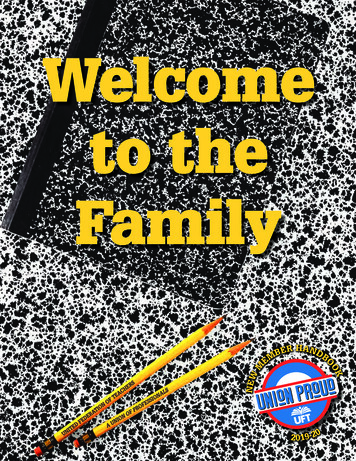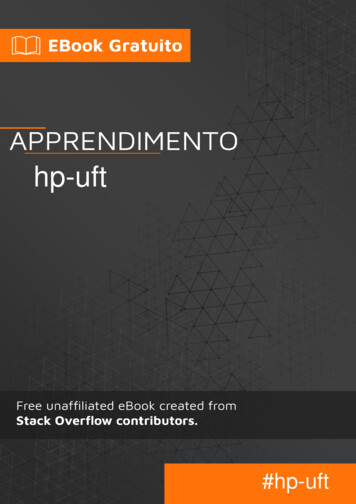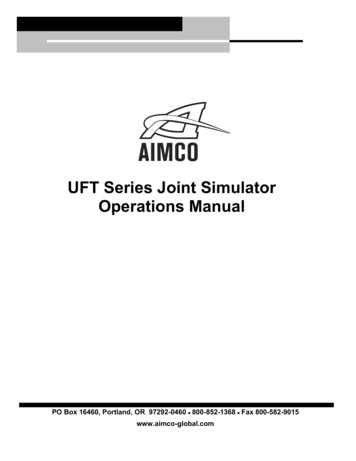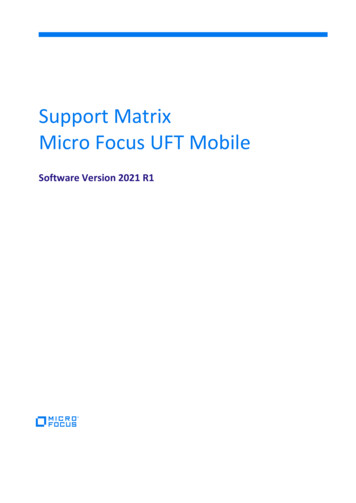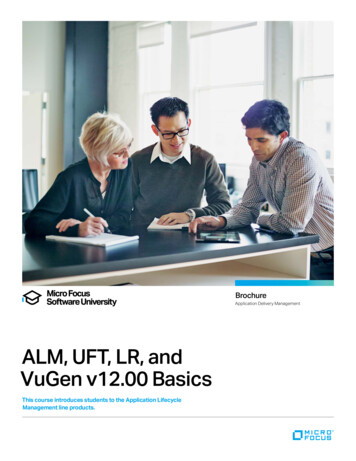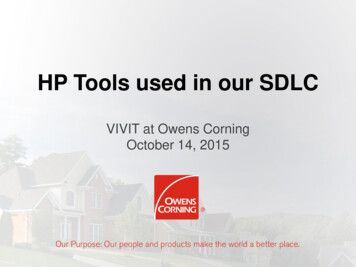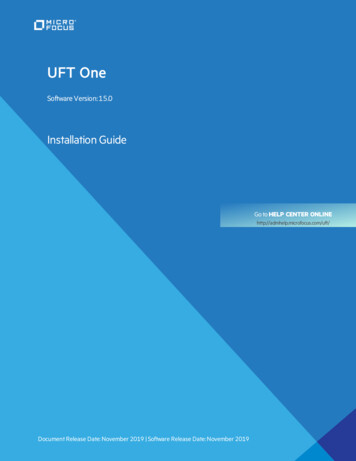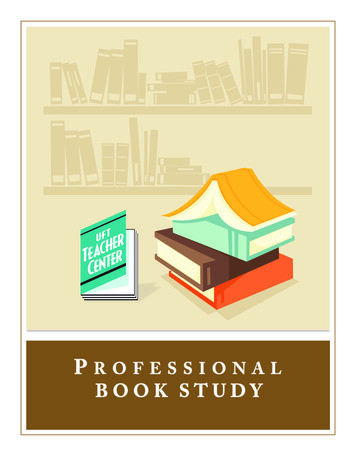
Transcription
PROFESSIONALBOOK STUDY
TABLE OF CONTENTSProfessional Book Study Introduction . 3Creating and Maintaining Your ProfessionalBook Study 4Professional Book Study Structures . 5Roles . 6Establishing Norms . 7Professional Book Study Planning Tool . 8Note-taking for Group Discussions . . 9Book Study Protocols . 10–15Works Cited . 16ProfessionalBook Study2
Professional Book Study IntroductionOne type of professional learning is a professional book study or book talk. Abook study can be a powerful way for educators to drive their own learning.Adult learning theory (Knowles, 2005) states that adults learn best when theirlearning is “self-directed and task-centered.”A book study is an effective form of professional learning because new learningcan be immediately applied in the classroom. Teachers are involved in multiplesessions over time where there is continuous discussion around a relevant topicthat has arisen from school data. Remember, the goal for any professionallearning is to have a positive impact on student learning!What is it?Professional book studies are (Ryley, 2012): Small groups of educators with similar interests and goals gatheredtogether to engage in professional discourse around a specific topic ofteaching and learning.Individuals committed to reading and discussing a selected book, guidedby the question: "How will this book influence professional practices atboth the classroom and school level?"Opportunities to build a shared knowledge base.How is it used?The professional book study process includes (Ryley, 2012): Identifying a topic, reviewing and selecting a book for study.Engaging in dialogues around specific content in the book, usually usingprofessional protocols.Committing to trying out ideas and strategies from the book.Studying to make recommendations to impact instruction in order topromote student achievement.How can our professional book study be successful?A book study group is successful when: All group members are involved in the decision-making processes.Every member is involved because they have an interest in learning moreabout the topic.Norms and protocols have been established as a group.There is time for reflection and celebration.ProfessionalBook Study3
Creating and MaintainingYour Professional Book Study1)Meet with your professional learning team. Refer to schoolwide educatorlearning targets to determine your area of study.2)Take time to research relevant books or scholarly authors around youridentified focus area. After researching, select one book for yourprofessional book study.3)Decide on the structure of book study group (see p. 5).4)As a team, determine the necessary roles for your group and define them(see p. 6). Decide if members of the team will hold the roles permanentlyor if the roles will be rotated amongst the members.5)Establish meeting dates that can accommodate all members of the team.6)At the first meeting, establish “norms” for working together (see p. 7).7)It is expected that participants will come to each subsequent meetingprepared to discuss the section or chapter for that day. Participants maycome with questions or comments to be included in the conversation.8)Consider using the planning tool (see p. 8) to guide each meeting.Possible meeting topics could include: discussing focus questions(determined by facilitator), discussing applications to classroom practice,and reflecting on what has changed as a result of your new learning onthe topic.9)Remember whatever you are discussing should be linked back to how itwill affect student learning, including academic and social-emotionaldevelopment.10) Take time to reflect on and celebrate the successes of your team.Consider presenting your key understandings and new instructionalpractices to another learning team.ProfessionalBook Study4
Professional Book Study Structures Chapter by Chapter: Group reads the book one chapter at a time. The team isresponsible for generating questions and discussion topicsto discuss from within that chapter. Independent Reading: Teams read independently and then debrief in pairs onwhat they have read. Group members work in pairs togenerate one thought-provoking question or comment tobring back to the group as a whole. This may work well forlarger groups. Applications of Ideas: After reading a section, the team discusses and directsspecific strategies they apply in the classroom. At the nextmeeting, participants will reflect on the strategies that theyapplied in the classroom focusing on what worked, didn’twork and why. Protocols:The group may choose one of several protocols to guide theirdiscussion. The use of protocols ensures that all voices areheard. There is opportunity for open conversation, dialogueand reflection. Consider using one of the following protocols(see pp. 10–15) from the School Reform Initiative(www.schoolreforminitiative.org) to guide your discussion: Text-Rendering Protocol (p.10)The Final Word (p.11)The Wagon Wheel (p. 12)Three Levels of Text (p. 13)ProfessionalBook Study5
RolesFacilitator: Is a neutral observer whose primary task is to maintain anorderly discussion. Gathers information from participants in order to creatediscussion questions/topics. Is responsible for pre-and post-meeting logistics. Helps to focus group on the common task.Recorder: Captures the discussion process using the participants’ ownwords and phrases. Consider using the notetaking sheet(see page 9). Records decisions and tasks assigned to individuals. Provides a clear, legible record of all aspects of the meeting,which must be approved by the participants before becominga permanent, public record.Reflector: Analyzes the processes of the meeting (did the group followestablished norms?). Identifies strengths and weaknesses of the process. Communicates how well the set agenda was followed.Time Keeper: Reminds group of time limits set to tasks. Ensures the group adheres to starting and ending times.ProfessionalBook Study6
Establishing NormsNorms Express the values of the team.Form a process to resolve conflict.Guide discussion of new ideas.Direct the flow of communication.Set limits on all team members.Define the roles of team members.Provide guidance for behavior of the team.Help the team to evaluate its performance.Support the needs of the team and the organization.Sample Norms:It’s okay to Ask questions.Say “I don’t know.”Disagree — as long as it is not an attack.Take the time to understand everyone’s point of view.Come to consensus.Compliment team members on contributions.Recognize different strengths in different people.Learn from each other and the professional literature.ProfessionalBook Study7
Professional Book Study Planning ToolDate:Members:Book Title:Chapter/Pages:Roles:Focus Questions: Applications toClassroom Practice:Reflections:(i.e. How has this topicinfluenced classroompractice? My planning?Student learning?)Next Steps:(i.e. What needs to beaccomplished before thenext meeting?)ProfessionalBook Study8
Note-Taking for Group DiscussionsQuestion or commentposed to the group:Who posed thequestion orcomment?What section of thetext is this commentaddressing? (pagenumber)Key discussion pointsand new learnings:ProfessionalBook StudyApplications to educatorpractice:9
Text Rendering Experience L]LSVWLK PU [OL ÄLSK I LK\JH[VYZ PurposeTo collaboratively construct meaning, clarify, and expand our thinking about a text or documentRolesA facilitator to guide the processA scribe to track the phrases and words that are sharedIntroductionTake a few moments to review the document and mark the sentence, the phrase, and the word(s) that youthink are particularly important for our work.Process1. First RoundEach person shares a ZLU[LUJL MYVT [OL KVJ\TLU[ [OH[ ZOL OL [OPURZ MLLSZ PZ WHY[PJ\SHYS ZPNUPÄJHU[ 2. Second RoundEach person shares a WOYHZL [OH[ ZOL OL [OPURZ MLLSZ PZ WHY[PJ\SHYS ZPNUPÄJHU[ ;OL ZJYPIL YLJVYKZ LHJO phrase.3. Third RoundEach person shares the VYK [OH[ ZOL OL [OPURZ MLLSZ PZ WHY[PJ\SHYS ZPNUPÄJHU[ ;OL ZJYPIL YLJVYKZ LHJO word.4. DiscussThe group discusses what they heard and what it says about the document. What new insights have you gained about the text by looking at it in this way? What do you think this text is LZZLU[PHSS about?5. DebriefThe group debriefs the text rendering process.Protocols are most powerful and effective when used within an ongoing professional learning community and facilitated by a skilled facilitator. To learn moreabout professional learning communities and seminars for facilitation, please visit the School Reform Initiative website at www.schoolreforminitiative.org.
The Final WordAdapted by Jennifer Fischer-Mueller and Gene Thompson-Grove.PurposeThe purpose of this protocol is to give each person in the group an opportunity to have their ideas,understandings, and perspective enhanced by hearing from others. With this protocol, the group canexplore an article, clarify their thinking, and have their assumptions and beliefs questioned in order to gaina deeper understanding of the issue.TimeFor each round, allow about 8 minutes (circles of 5 participants: presenter 3 minutes, response 1 minuteLHJO MVY WLVWSL ÄUHS VYK MVY WYLZLU[LY TPU\[L ;V[HS [PTL PZ HIV\[ TPU\[LZ MVY H NYV\W VM TPU\[LZ MVY H NYV\W VM TPU\[LZ MVY H NYV\W VM RolesFacilitator/time-keeper OV HSZV WHY[PJPWH[LZ " WHY[PJPWHU[ZFacilitation /H]L WHY[PJPWHU[Z PKLU[PM VUL TVZ[ ZPNUPÄJHU[ PKLH MYVT [OL [L [ \UKLYSPULK VY OPNOSPNO[LK HOLHK VM [PTL :[PJR [V [OL [PTL SPTP[Z (]VPK KPHSVN\L /H]L LX\HS ZPaLK JPYJSLZ ZV HSS ZTHSS NYV\WZ ÄUPZO H[ HWWYV PTH[LS [OL ZHTL [PTLProcess :P[ PU H JPYJSL HUK PKLU[PM H MHJPSP[H[VY [PTLRLLWLY ,HJO WLYZVU ULLKZ [V OH]L VUL TVZ[ ZPNUPÄJHU[ PKLH MYVT [OL [L [ \UKLYSPULK VY OPNOSPNO[LK PU [OL article. It is often helpful to identify a back-up quote as well. ;OL ÄYZ[ WLYZVU ILNPUZ I YLHKPUN OH[ Z[Y\JR OPT VY OLY [OL TVZ[ MYVT [OL HY[PJSL /H]L [OPZ WLYZVU refer to where the quote is in the text - one thought or quote only. Then, in less than 3 minutes, thisperson describes why that quote struck her/him. For example, why does she/he agree/disagree with thequote? What questions does she/he have about that quote? What issues does it raise for her/him? Whatdoes she/he now wonder about in relation to that quote? *VU[PU\PUN HYV\UK [OL JPYJSL LHJO WLYZVU IYPLÅ YLZWVUKZ [V [OH[ X\V[L HUK OH[ [OL WYLZLU[LY ZHPK PU less than a minute. The purpose of the response is: ;V L WHUK VU [OL WYLZLU[LY»Z [OPURPUN HIV\[ [OL X\V[L HUK [OL PZZ\LZ YHPZLK MVY OPT VY OLY I [OL X\V[L ;V WYV]PKL H KPMMLYLU[ SVVR H[ [OL X\V[L ;V JSHYPM [OL WYLZLU[LY»Z [OPURPUN HIV\[ [OL X\V[L ;V X\LZ[PVU [OL WYLZLU[LY»Z HZZ\TW[PVUZ HIV\[ [OL X\V[L HUK [OL PZZ\LZ YHPZLK HS[OV\NO H[ [OPZ [PTL [OLYL PZ UV YLZWVUZL MYVT [OL WYLZLU[LY Protocols are most powerful and effective when used within an ongoing professional learning community and facilitated by a skilled facilitator. To learn moreabout professional learning communities and seminars for facilitation, please visit the School Reform Initiative website at www.schoolreforminitiative.org.
(M[LY NVPUN HYV\UK [OL JPYJSL P[O LHJO WLYZVU OH]PUN YLZWVUKLK MVY SLZZ [OHU VUL TPU\[L [OL WLYZVU [OH[ ILNHU OHZ [OL ÄUHS VYK ¹ 0U UV TVYL [OHU VUL TPU\[L [OL WYLZLU[LY YLZWVUKZ [V OH[ OHZ ILLU said. Now what is she/he thinking? What is her/his reaction to what she/he has heard?6. The next person in the circle then begins by sharing what struck him or her most from the text. ProceedHYV\UK [OL JPYJSL YLZWVUKPUN [V [OPZ UL [ WYLZLU[LY»Z X\V[L PU [OL ZHTL H HZ [OL ÄYZ[ WYLZLU[LY»Z ;OPZ process continues until each person has had a round with his or her quote. ,UK I KLIYPLÄUN [OL WYVJLZZ PU V\Y ZTHSS NYV\W Protocols are most powerful and effective when used within an ongoing professional learning community and facilitated by a skilled facilitator. To learn moreabout professional learning communities and seminars for facilitation, please visit the School Reform Initiative website at www.schoolreforminitiative.org.
Wagon WheelsAdapted for Texts L]LSVWLK I LK\JH[VYZ PU [OL ÄLSK HUK YL]PZLK I *VUUPL 7HYYPZO HUK :\ZHU ;H SVY PurposeTo deepen understanding of a text; to explore implications for participants’ work5V[L! HNVU OLLS Z[Y\J[\YL TH HSZV IL \ZLK [V IYHPUZ[VYT HU PZZ\L VY [VWPJ :LL Wagon WheelsBrainstorm Set-Up -V\Y JOHPYZ IHJR [V IHJR H[ [OL O\I VM [OL OLLS HUK JOHPYZ VU [OL V\[LY JPYJSL MHJPUN [OL JOHPYZ H[ [OL O\I :PUJL [OPZ WYVJLZZ PZ KVUL PU H RULL [V RULL¹ MVYTH[ P[OV\[ [HISLZ P[»Z OLSWM\S MVY WHY[PJPWHU[Z [V IYPUN YLÅLJ[PVU QV\YUHSZ [V SLHU HNHPUZ[ ;OL HSZV IYPUN [OLPY [L [Z ZVTL[OPUN [V YP[L P[O HUK WLYOHWZ ZVTL Z[PJR UV[LZ MVY QV[[PUN KV U PKLHZ ,HJO HNVU OLLS VW[PTHSS PUJS\KLZ VY WHY[PJPWHU[Z 0M V\ OH]L HU \UL]LU U\TILY V\ JHU OVVR [VNL[OLY WHY[PJPWHU[Z VU [OL OLLS O\I OPJO [OLU ILJVTLZ H KPZJ\ZZPVU [YPHK YH[OLY [OHU H WHPY :LL L HTWSLZ ILSV !Procedural Notes ;OL WLVWSL VU [OL V\[ZPKL VM [OL OLLS PSS IL TV]PUN VUL ZLH[ [V [OL SLM[ VY YPNO[ H[ LHJO YV[H[PVU" [OL WLVWSL ZLH[LK H[ [OL O\I YLTHPU PU [OLPY ZLH[Z , WSHPU [OH[ [OL PSS IL VYRPUN VU VUL N\PKPUN X\LZ[PVU VY WPLJL VM [L [ P[O LHJO WHY[ULY MVY HWWYV PTH[LS five TPU\[LZ ¶ P L [OL PSS VYR P[O four KPMMLYLU[ WHY[ULYZ K\YPUN [OL HJ[P]P[ ¶ [Y PUN [V HTWSPM [OLPY \UKLYZ[HUKPUNZ VM [OL [L [ HUK HU PTWSPJH[PVUZ MYVT [OL [L [ MVY [OLPY VYR ([ [OL LUK VM LHJO YV[H[PVU HZR LHJO WHY[PJPWHU[ ZP[[PUN VU [OL V\[ZPKL VM [OL OLLS [V YV[H[L VUL ZLH[ [V [OL SLM[ (M[LY [OL ZL[[SL KV U NP]L [OLT [OL UL [ X\LZ[PVU X\V[H[PVU [VWPJ HUK HZR [OLT [V VUJL HNHPU HTWSPM HUK L [LUK [OLPY \UKLYZ[HUKPUNZ Protocols are most powerful and effective when used within an ongoing professional learning community and facilitated by a skilled facilitator. To learn moreabout professional learning communities and seminars for facilitation, please visit the School Reform Initiative website at www.schoolreforminitiative.org.
Debrief:VTL PKLHZ MVY Z[Y\J[\YPUN KPZJ\ZZPVU! @V\ TPNO[ VMMLY N\PKPUN X\LZ[PVUZ MVY YV\UKZ P L OH[ HZ JVUÄYTLK VY JVUM\ZPUN PU [OL [L [& OH[ TPNO[ V\ JVUZPKLY \ZPUN MYVT [OL [L [& @V\ TPNO[ PKLU[PM ZHSPLU[ X\V[H[PVUZ VY KPYLJ[ WHY[PJPWHU[Z [V WHY[PJ\SHY WSHJLZ PU [OL [LZ[ VUL WLY YV\UK ([ [OL ILNPUUPUN VM H YV\UK V\ V\SK KPYLJ[ WHY[PJPWHU[Z [V H WHNL U\TILY HUK X\V[L YLHK P[ HSV\K HUK [OLU WVZ[ P[ HZ H YLTPUKLY 7HY[PJPWHU[Z [\YU [V [OH[ WSHJL YLHK [OL X\V[L [OPUR HIV\[ HUK [OLU KPZJ\ZZ P[ 0[»Z PTWVY[HU[ [V WYV]PKL H TVTLU[ VY two H[ [OL ILNPUUPUN VM LHJO YV\UK K\YPUN OPJO WHY[PJPWHU[Z JHU NV IHJR PU[V [OL [L [ ;OPZ KLLWLUZ [OL [HSR Protocols are most powerful and effective when used within an ongoing professional learning community and facilitated by a skilled facilitator. To learn moreabout professional learning communities and seminars for facilitation, please visit the School Reform Initiative website at www.schoolreforminitiative.org.
Three Levels of Text ProtocolAdapted by the Southern Maine Partnership from Camilla Greene’s Rule of 3 Protocol, November, 2003.PurposeThis protocol is designed to deepen the understanding of a text and explore implications for participants’work. It asks participants to respond to 3 levels of the text: literal (level 1), interpretation (level 2), andimplications (level 3)FacilitationStick to the time limits. Each round takes up to 5 minutes per person in a group. Emphasize the need towatch air time during the brief group response segment. Do 1-3 rounds. Can be used as a prelude to atext-based discussion or by itself.RolesFacilitator/timekeeper (who also participates); participantsProcess1. Sit in a circle and identify a facilitator/timekeeper.2. If participants have not done so ahead of time, have them read the text and identify passages that theyfeel may have important implications for their work.3. Do 1-3 rounds. A round consists of: 6UL WLYZVU \ZPUN \W [V TPU\[LZ [V!Level 1: Read aloud the passage she/he has selectedLevel 2: Say what she/he thinks about the passage (interpretation, connection to past experiences, etc.)Level 3: Say what she/he sees as the implications for her/his work. ;OL NYV\W YLZWVUKPUN MVY H total of up to 2 minutes) to what has been said.4. After all rounds have been completed, debrief the process.Protocols are most powerful and effective when used within an ongoing professional learning community and facilitated by a skilled facilitator. To learn moreabout professional learning communities and seminars for facilitation, please visit the School Reform Initiative website at www.schoolreforminitiative.org.
Works CitedKnowles, M., & Holton, E. The Adult Learner: The Definitive Classic inAdult Education and Human Resource Development. 6th ed.Amsterdam: Elsevier, 2005. Print.“Protocol Alphabetical List: School Reform Initiative.” School ReformInitiative. Web. 3 Oct. 2014.Thompson-Grove, G. “The Final Word.” School Reform Initiative.”School Reform Initiative, 1 Jan. 2014. Web 3 Oct. 2014.Ryley, H. (2012). "Professional Book Study." Benchmark One Blog.Web. 10 Sept. 2014.16
ProfessionalBook Study 3! Professional Book Study Introduction One type of professional learning is a professional book study or book talk. A book study can be a powerful way for educators to drive their own learning. Adult learning theory (Knowles, 2005) states that adults learn best when their learning is "self-directed and task-centered."
